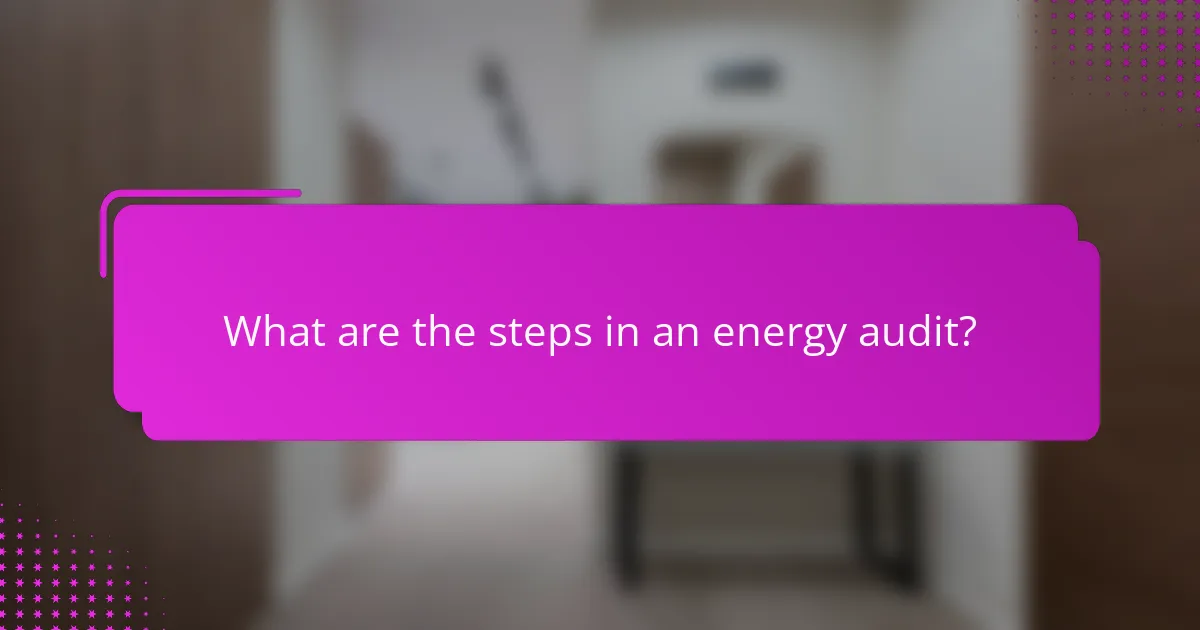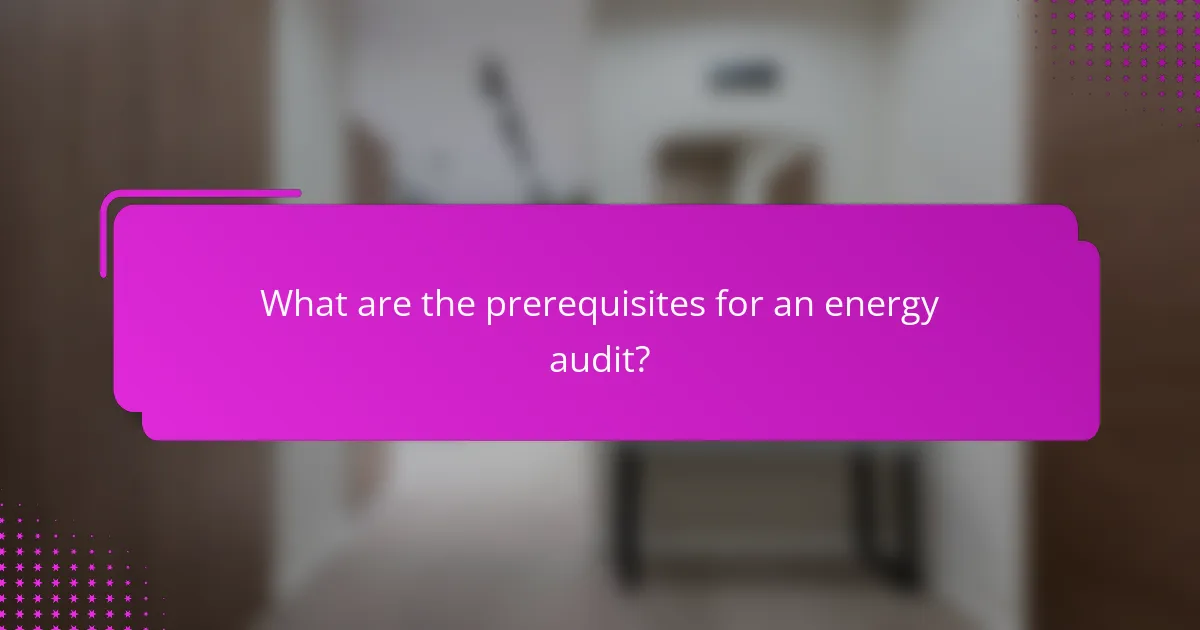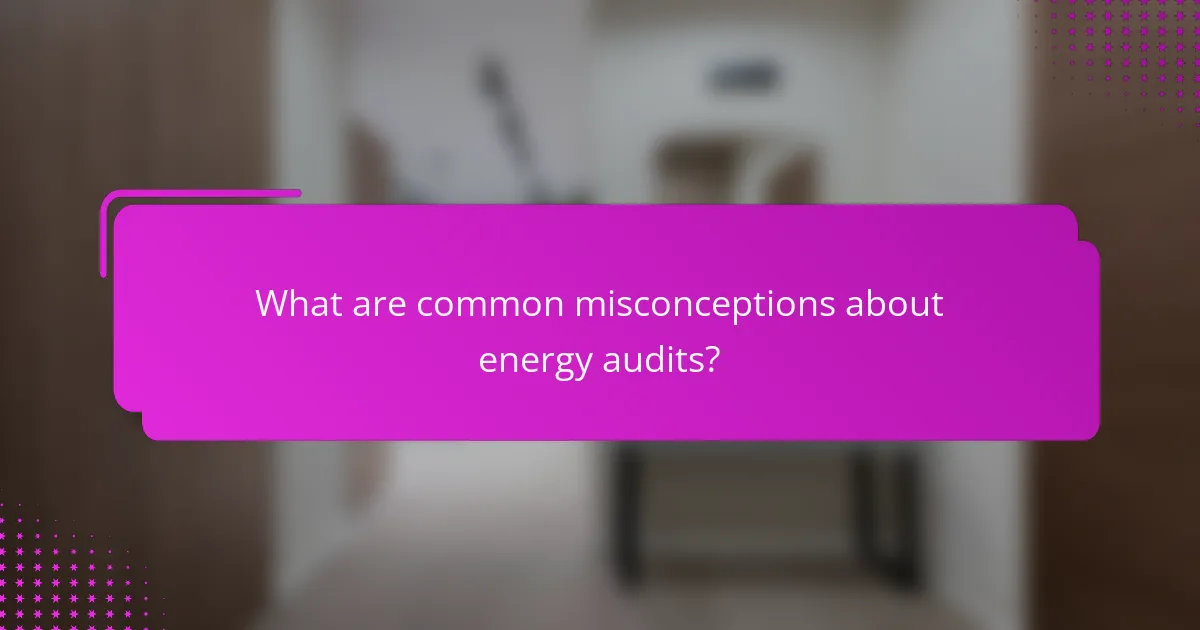An energy audit is a comprehensive assessment of a building’s energy consumption aimed at identifying opportunities for increased efficiency. By following a systematic process and utilizing specialized tools, auditors can pinpoint areas for improvement, leading to significant cost savings and enhanced sustainability. The benefits of conducting an energy audit extend beyond financial savings, contributing to a more comfortable and healthier indoor environment.

What are the steps in an energy audit?
An energy audit involves a systematic evaluation of energy use in a building to identify opportunities for efficiency improvements. The process typically includes several key steps that help pinpoint areas where energy consumption can be reduced and costs minimized.
Initial assessment
The initial assessment is the first step in an energy audit, where the auditor gathers basic information about the building’s energy systems and usage patterns. This includes understanding the building’s size, age, occupancy, and existing energy systems such as heating, cooling, and lighting.
During this phase, the auditor may conduct a walkthrough to identify obvious inefficiencies, such as outdated equipment or poor insulation. This preliminary evaluation sets the stage for more detailed analysis later in the audit process.
Data collection
Data collection involves gathering detailed information on energy consumption, costs, and operational practices. This may include reviewing utility bills, energy management systems, and conducting surveys with building occupants to understand usage habits.
Auditors often use tools like energy monitoring software to track real-time energy use and identify trends. This data is crucial for establishing a baseline for energy performance and identifying specific areas for improvement.
Analysis of energy usage
In this step, the auditor analyzes the collected data to evaluate how energy is used throughout the building. This analysis helps identify patterns, peak usage times, and areas where energy is wasted.
Common methods include benchmarking against similar buildings or industry standards, which can reveal significant discrepancies in energy performance. The goal is to pinpoint inefficiencies and prioritize them based on potential savings and impact.
Recommendations for improvements
Based on the analysis, the auditor provides recommendations for energy efficiency improvements. These suggestions may include upgrading equipment, enhancing insulation, or implementing energy management practices.
Recommendations should be practical and tailored to the specific building context, considering factors like budget constraints and potential return on investment. Prioritizing actions based on cost-effectiveness can help ensure the best use of resources.
Implementation plan
The implementation plan outlines the steps needed to execute the recommended improvements. This includes timelines, responsible parties, and estimated costs for each action item.
It is essential to establish clear goals and metrics for success, allowing for tracking progress and making adjustments as needed. Engaging stakeholders early in the process can facilitate smoother implementation and foster support for energy efficiency initiatives.

What tools are used for energy audits?
Energy audits utilize various tools to assess energy consumption and identify efficiency improvements. These tools help auditors gather data, analyze energy use patterns, and recommend actionable changes to reduce costs and enhance sustainability.
Energy monitoring software
Energy monitoring software tracks and analyzes energy consumption in real-time. It provides insights into usage patterns, peak demand times, and areas for improvement, allowing businesses to make informed decisions about energy efficiency.
When selecting software, consider features like user-friendliness, integration capabilities with existing systems, and the ability to generate detailed reports. Popular options include Energy Star Portfolio Manager and Lucid BuildingOS.
Infrared thermography cameras
Infrared thermography cameras detect heat loss and insulation deficiencies by capturing thermal images of buildings. These cameras reveal temperature variations that indicate air leaks or inadequate insulation, which can lead to energy waste.
Using these cameras requires some training to interpret the images correctly. They are particularly useful in identifying problems in hard-to-reach areas, such as roofs and walls, making them a valuable tool for comprehensive energy audits.
Blower door tests
Blower door tests measure a building’s airtightness by creating a pressure difference between the inside and outside. This test helps identify air leaks that contribute to energy loss, allowing for targeted improvements.
During the test, a fan is mounted in an exterior door frame to draw air out of the building. The resulting pressure change is measured, and the air leakage rate is calculated, typically expressed in air changes per hour (ACH). A well-sealed building usually has an ACH of less than 1.
Smart meters
Smart meters provide real-time data on energy consumption, allowing users to monitor their usage patterns and costs. They enable consumers to make informed decisions about energy use and identify peak usage times for potential savings.
These devices often come with online platforms or apps that display usage data, helping users track their energy consumption trends over days, weeks, or months. Many utility companies offer incentives for installing smart meters, making them a cost-effective option for enhancing energy efficiency.

What are the benefits of conducting an energy audit?
Conducting an energy audit offers significant advantages, including cost savings, enhanced efficiency, and improved indoor environments. By identifying energy waste and optimizing usage, property owners can enjoy lower utility bills and a more comfortable living or working space.
Cost savings on energy bills
One of the primary benefits of an energy audit is the potential for substantial cost savings on energy bills. By pinpointing areas of excessive energy consumption, homeowners can implement targeted improvements that often lead to reductions of 10-30% in monthly energy expenses.
Common measures include upgrading insulation, sealing leaks, and replacing outdated appliances with energy-efficient models. These changes not only lower bills but can also provide a quick return on investment.
Improved energy efficiency
An energy audit helps identify inefficiencies in a building’s energy use, allowing for strategic upgrades that enhance overall energy efficiency. This can involve optimizing heating and cooling systems, improving lighting, and utilizing smart technology to monitor usage.
Implementing these recommendations can lead to a more sustainable operation, reducing the overall carbon footprint and contributing to environmental conservation efforts.
Enhanced comfort and indoor air quality
Energy audits can significantly improve comfort levels within a property by addressing issues like drafts, uneven temperatures, and poor ventilation. By enhancing insulation and sealing air leaks, occupants can enjoy a more consistent and comfortable indoor climate.
Additionally, better air quality can result from improved ventilation systems and the reduction of pollutants, leading to healthier living and working environments.
Increased property value
Investing in an energy audit and subsequent improvements can increase a property’s market value. Energy-efficient homes are often more attractive to buyers, as they promise lower utility costs and a reduced environmental impact.
Furthermore, properties that meet energy efficiency standards may qualify for tax incentives or rebates, making them even more appealing in the real estate market.

How to choose an energy audit service in the US?
To choose an energy audit service in the US, focus on their certifications, customer feedback, and the range of services offered. Selecting a qualified provider can help ensure you receive a thorough assessment that meets your energy efficiency needs.
Check certifications and qualifications
When evaluating energy audit services, verify their certifications and qualifications. Look for professionals certified by recognized organizations, such as the Building Performance Institute (BPI) or the Residential Energy Services Network (RESNET).
These certifications indicate that the auditor has undergone specific training and adheres to industry standards. Additionally, check if they comply with local regulations and guidelines, which can vary by state.
Read customer reviews
Customer reviews provide valuable insights into the quality of service offered by energy audit providers. Look for testimonials on independent review sites or ask for references from previous clients.
Pay attention to feedback regarding the thoroughness of the audit, professionalism of the staff, and overall satisfaction. A pattern of positive reviews can indicate a reliable service, while consistent negative feedback may be a red flag.
Compare pricing and services
When comparing energy audit services, consider both pricing and the specific services included. Prices can vary widely, typically ranging from a few hundred to over a thousand dollars, depending on the complexity of the audit and the size of the property.
Ensure you understand what is included in the price, such as follow-up consultations or detailed reports. It may be beneficial to request quotes from multiple providers to find a balance between cost and quality of service.

What are the prerequisites for an energy audit?
Before conducting an energy audit, it’s essential to gather relevant documentation and ensure access to all areas of the property. This preparation helps auditors identify energy-saving opportunities effectively.
Building plans and energy bills
Having the building plans and recent energy bills is crucial for an energy audit. The plans provide insights into the layout, insulation, and systems in place, while energy bills reveal consumption patterns and costs.
Review at least 12 months of energy bills to identify trends and peak usage times. This data can help pinpoint areas where energy efficiency can be improved, such as outdated appliances or heating systems.
Access to all areas of the property
Access to all areas of the property, including attics, basements, and mechanical rooms, is vital for a thorough energy audit. Auditors need to inspect insulation, HVAC systems, and any potential air leaks.
Ensure that all areas are accessible and that any necessary permissions are obtained. This may involve clearing pathways or scheduling times for access if certain areas are restricted.

What are common misconceptions about energy audits?
Many people believe that energy audits are only for large businesses or that they are too costly to implement. In reality, energy audits can benefit any size of facility and often lead to significant savings that outweigh initial costs.
Energy audits are only for large buildings
A common misconception is that energy audits are exclusively for large commercial buildings. However, residential properties and small businesses can also gain valuable insights from energy audits. These assessments help identify inefficiencies and suggest improvements that can lead to lower energy bills.
For instance, a small café might discover that upgrading to energy-efficient lighting can reduce its electricity costs by a notable percentage. Thus, energy audits are beneficial across various property types.
Energy audits are too expensive
Many assume that the cost of an energy audit is prohibitive. While there may be upfront costs, numerous programs and incentives exist to subsidize these expenses, especially in regions focused on energy efficiency. In some cases, audits can be conducted for a few hundred dollars, and the savings from implementing recommendations often exceed the audit cost.
Additionally, local utility companies may offer rebates or free audits as part of energy conservation programs, making it more accessible for homeowners and small businesses.
Energy audits only identify problems
Some people think energy audits solely highlight issues without providing solutions. In reality, auditors not only pinpoint inefficiencies but also recommend actionable steps to enhance energy performance. This includes suggesting upgrades, behavioral changes, or even operational adjustments that can lead to energy savings.
For example, an audit might reveal that a building’s HVAC system is running inefficiently, and the auditor can recommend specific maintenance or replacement strategies to improve efficiency.


